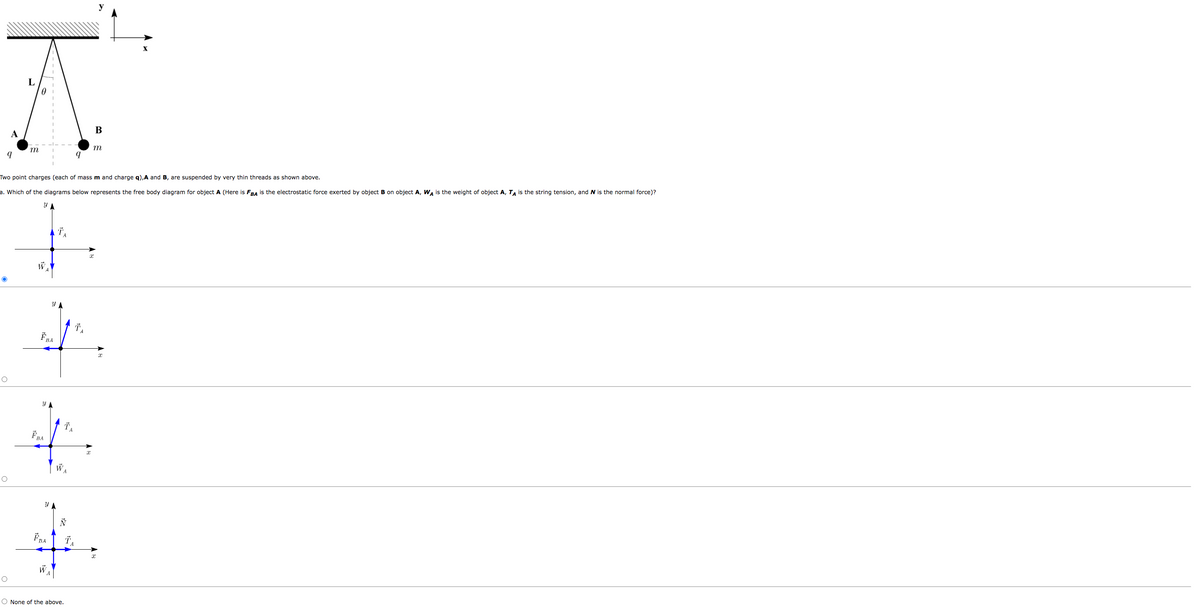L A B m 112 b 0 Two point charges (each of mass m and charge q).A and B, are suspended by very thin threads as shown above. a. Which of the diagrams below represents the free body diagram for object A (Here is Fa is the electrostatic force exerted by object B on object A., WA is the weight of object A, TA is the string tension, and N is the normal force)?
L A B m 112 b 0 Two point charges (each of mass m and charge q).A and B, are suspended by very thin threads as shown above. a. Which of the diagrams below represents the free body diagram for object A (Here is Fa is the electrostatic force exerted by object B on object A., WA is the weight of object A, TA is the string tension, and N is the normal force)?
Chapter5: Electric Charges And Fields
Section: Chapter Questions
Problem 124AP: The charge unit length on the thin shown below is .What is the force on the point charge q? Solve...
Related questions
Question

Transcribed Image Text:L
A
B
A
m
m
q
9
Two point charges (each of mass m and charge q),A and B, are suspended by very thin threads as shown above.
a. Which of the diagrams below represents the free body diagram for object A (Here is FBA is the electrostatic force exerted by object B on object A, WA is the weight of object A, TA is the string tension, and N is the normal force)?
O
O
O
W
FBA
YA
ap
FBA
WA
TA
TA
O None of the above.
y
I
1.
FBA
X

Transcribed Image Text:b. Assume that the system is in equilibrium. The x and y components of Newton's second law for object A can be written as:
Ox: TA tan 8- FBA = 0
Y: TA - WA = 0
Ox: TA FBA = 0
Ox: TA sin 8- FBA = 0
Ox: TA COS 8- FBA = 0
Ox: TA cos 0+ FBA = 0
Submit Answer Tries 0/1
Y: TAWA = 0
y: TA cOS - WA = 0
y: TA sin 8-WA = 0
y: TA sin 8- WA = 0
c. Trying to find the angle 8 for the equilibrium position is difficult for the general case. The math, however, becomes simpler if the equilibrium angle is small (i.e. making the small angle approximation). Explain how the small angle approximation can be used in this problem. Using this approximation derive a formula that gives the equilibrium angle <m>0 as a function of the charges q, the length of the string L, the
mass of the object m and, if needed one or more known constants.
Expert Solution
This question has been solved!
Explore an expertly crafted, step-by-step solution for a thorough understanding of key concepts.
Step by step
Solved in 3 steps with 3 images

Knowledge Booster
Learn more about
Need a deep-dive on the concept behind this application? Look no further. Learn more about this topic, physics and related others by exploring similar questions and additional content below.Recommended textbooks for you


Principles of Physics: A Calculus-Based Text
Physics
ISBN:
9781133104261
Author:
Raymond A. Serway, John W. Jewett
Publisher:
Cengage Learning

College Physics
Physics
ISBN:
9781938168000
Author:
Paul Peter Urone, Roger Hinrichs
Publisher:
OpenStax College


Principles of Physics: A Calculus-Based Text
Physics
ISBN:
9781133104261
Author:
Raymond A. Serway, John W. Jewett
Publisher:
Cengage Learning

College Physics
Physics
ISBN:
9781938168000
Author:
Paul Peter Urone, Roger Hinrichs
Publisher:
OpenStax College

Physics for Scientists and Engineers: Foundations…
Physics
ISBN:
9781133939146
Author:
Katz, Debora M.
Publisher:
Cengage Learning

College Physics
Physics
ISBN:
9781285737027
Author:
Raymond A. Serway, Chris Vuille
Publisher:
Cengage Learning

Physics for Scientists and Engineers with Modern …
Physics
ISBN:
9781337553292
Author:
Raymond A. Serway, John W. Jewett
Publisher:
Cengage Learning